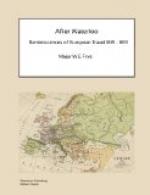The whole road between Spoleto and Foligno is thro’ a beautiful valley in high cultivation. There is a good deal of rich pasture ground, and it is watered by the river called in ancient tunes Clitumnus. Here are to be seen a fine breed of white cattle for which this part of the country has been long renowned, which cattle were used, in preference, for sacrifices (Albi, Clitumne, greges).[116] A similar breed is to be found in India and Egypt.
The streets in Foligno are broad. I remarked the Palazzo Pubblico and Cathedral as very fine buildings. Our next day’s journey brought us to Perugia, after passing by Assisi, the birth place of the famous St Francis, founder of the order of Franciscans. It is situated on an eminence: convents and churches abound therein.
Perugia is a large and opulent city, standing like a fortress on a mountain, and towering over the plain below. It is of steep ascent from the plain, and there are various terraces along the ramparts, commanding several fine points of view of the rich and fertile plains all round. These terraces are planted with trees and form the promenades appertaining to the city. The architecture of the various churches and Palaces is very superior. The streets are broad and every building has an air of magnificence. The Cathedral, dedicated to St Laurence, is well worth visiting; it stands on the Piazza del Duomo, where there is a fine fountain ornamented with statues. In the church of St Peter’s there are some fine columns of marble and some pictures of Perugino and Raffaello.
[108] Virgil, Aen., VI, 886.—ED.
[109] Of the two persons here mentioned, by their
initials only, the first,
Luigi de’ Medici, was
chosen as Chancellor of the Exchequer by King
Ferdinando in June, 1815.
The second was Nugent, an Austrian
marescallo, who became
capitano generale of the Neapolitan army,
August, 1816, and capo
del supremo comando, February, 1817.—ED.
[110] This most distinguished lady, Marianna Candidi,
was born in Rome in
1756; her mother, Magdalena
Scilla, was the daughter of a well known
antiquary of Messina, Agostino
Scilla. Marianna learned Latin, drawing
and music; she achieved a
reputation as landscape painter, and was
elected a member of the Academies
of St Luke in Rome, of Bologna, Pisa
and Philadelphia. She
married the lawyer Domenico Dionigi, and gave him
seven children, one of whom,
Henrietta, became Madame Orfei, and was
much esteemed as “improvisatrice.”
Madame Dionigi herself published
several works, among which
a Storia de’ tempi presenti, written in
view of the education of her
children. Her salon in Rome was
frequented by many men of
distinction, such as Visconti, d’Agincourt,
Erskine, etc. She
died on the 10th June, 1826, at the age of seventy.
—ED.




